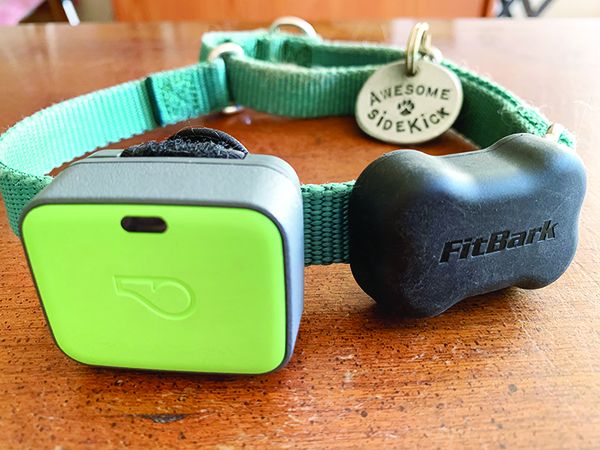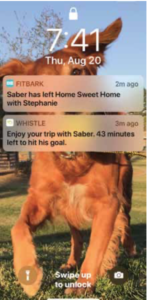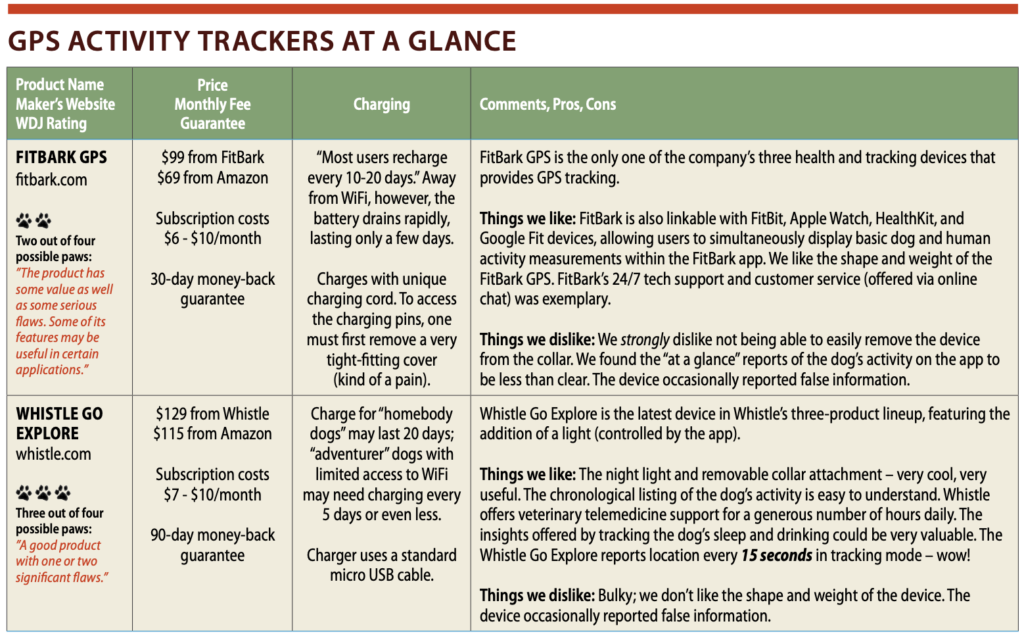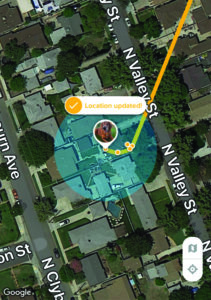
I’ve been a FitBit user since 2013. When my dog is off-leash, I’ve often wondered about the overall distance of his adventures, since when we hike, he often runs ahead and doubles back, frequently checking in with me. If my FitBit says I hiked six miles, how far did Saber go if he spent much of the time running back and forth? I don’t really need to know, but I’ve always been curious.
So, for this and other reasons, I jumped at the chance to research and test a couple of consumer-grade pet health and activity trackers: Whistle Go Explore and FitBark GPS.
FITNESS NOT ABSENCE
While many dog owners are drawn to these products for their potential to help locate a dog who may have escaped, this is not their best use (see “Technology Is No Substitute for Training and/or Management,” page 19). The products are better at (and arguably more valuable for) monitoring and tracking a dog’s overall activity. This has many potential uses:
* Setting and helping meet daily exercise goals for a pet – especially useful if you’re trying to help your dog shed a few pounds or improve her overall condition.
* Better understanding when your dog is most active while you’re away from home. In some cases, activity patterns can be tied to health or behavior issues that are otherwise difficult to monitor when you aren’t home.
* Knowing when the dog walker arrives and how long your dog was walked.
* Knowing how often your dog is up at night. Potential health issues or insufficient exercise and mental stimulation during the day can cause restlessness at night, which can be missed if you’re a heavy sleeper.
Some of the product reviews – and even some of the marketing materials – suggest that location trackers can be used to find escape-artist dogs. Sure, a GPS tracker might help you find your dog if he escapes, but perhaps not before he’s been hit by a car trying to cross a busy street.
If your main motivation for buying a GPS tracker for your dog is because he tends to jump or dig out from under your fence, we’d recommend that you spend your money on fortifying the fence, instead. Or, install an escape-proof dog run, perhaps with a top for the extreme jumpers or efficient climbers. (And if you have money left over, spend some on making the backyard a little more enriching; see “Five Ways to Make Your Dog’s Yard Safe & Fun,” WDJ September 2020.)
What about dogs who dart out the front door when you open it? Teach your dog a go-to-mat behavior and, if needed, use a baby gate in the doorway or an x-pen outside the front door as an airlock. (See “Put a Stop to Door-Darting,” WDJ September 2017.)
If owners of escape-artist dogs are employing smart training and careful environmental management, and choose to add a GPS tracker as an added layer of protection, great! Because, of course, accidents happen, even among the most careful pet owners.
Be aware, though, that while the GPS activity trackers we tested could help locate a dog within a day or two of an escape, lacking a connection to your WiFi, the batteries on these products don’t maintain a charge long enough to help you find him after that. They won’t help you locate a livestock guardian dog who occasionally takes off for days at a time or a hunting dog prone to following a scent too far.
THE CONTENDERS
We chose to review the two best-selling products in this category. The choice was also partially based on the amount of time their makers had invested in the ongoing development of the products (which were both introduced to the market in 2013). The products are:
* Whistle Go Explore. This is the latest device in Whistle’s three-product lineup. It succeeds the Whistle Go, offering longer battery life (up to 20 days vs. Whistle Go’s estimated 10 days) and features the addition of a light (controlled by the app).
* FitBark GPS. This is one of FitBark’s three health and tracking devices, and the only product that provides GPS tracking.
Both devices require an initial purchase price (the Go Explore costs $115 to $130, the FitBark GPS costs $70 to $100; both cost less when purchased from Amazon.com than from their makers) and a subscription fee. Whistle’s plans range from $10 per month (paid monthly, but with a one-year contract) to $7 a month (with a two-year contract, paid in advance). FitBark plans range from $10 per month (with no contract) to $6 per month (with a three-year contract, paid in advance).
HOW THEY WORK

Both Whistle Go Explore and FitBark GPS are GPS-enabled accelerometers that track the wearer’s movement multiple times per second and use algorithms to identify movement as specific behaviors. Whistle Go Explore identifies movement as resting, active, walking, running, or playing, and can identify licking and scratching. FitBark identifies movement as resting, active, or playing.
For location tracking purposes, both products are assisted-GPS devices, meaning they use information from cellular towers (Whistle uses ATT’s network; FitBark uses Verizon) and satellites to triangulate position and transmit data to the user via proprietary mobile device apps. This means the trackers only work in areas with cellular reception, and they are subject to various conditions that can interfere with cellular wavelength transmission – from inclement weather to tall buildings or competing frequencies.
Both products function essentially the same way: When the wearer is in a predetermined “safe zone,” the device connects to a designated WiFi network and syncs in the background. In our test, I connected each device to both my home WiFi and the WiFi at work, since my dog Saber is frequently with me at the office.
When the device is taken from or returned to a WiFi-enabled “safe zone,” it sends an alert notification. If the device is within Bluetooth range of an authorized person, the alert will specify who the dog is with.
The devices can be linked to multiple authorized people’s mobile devices, which lends itself to custom notifications. For example, if the dog regularly leaves the “safe zone” with a dog walker, linking the device to the dog walker’s phone will allow you to receive a notification saying the dog has left with that specific person.
While out on an authorized adventure, the GPS function will report location at fixed intervals, so long as the device is able to get an accurate location. Whistle Go Explore’s reporting interval can be adjusted to every 3, 6, 10, 15, or 30 minutes. FitBark reports location every minute. Activity and location are tracked at the set interval and visible in real-time via the app. When the user returns to the designated WiFi network, the data is synced for record keeping, along with a map graphic depicting the area traveled.
When neither WiFi nor a recognized Bluetooth connection is available, and the device is outside of a “safe zone,” it sends a generic alert (“Heads Up! Saber has left Home Sweet Home”) and the tracking feature becomes available. If you’re aware that the dog is not with an authorized person, the notification would prompt you to start the tracking mode and go look for your dog.
When Whistle Go Explore is in tracking mode, it updates location information every 15 seconds. FitBark continues to update at one-minute intervals, but location data gathered in tracking mode is said to be more precise than data gathered when the tracker is paired via Bluetooth to an owner’s mobile device.

COMPARING THE PRODUCTS
While the two products we tested are similar, they both had specific strengths and weaknesses:
* Setup. Both products arrived with minimal packaging, and setup was quick and easy. The Whistle Go Explore successfully paired with the corresponding app on my phone during the initial charging session, allowing me to set up everything in one sitting. The FitBark required an initial charge before becoming “visible” to the app on my phone.
Both apps ask for basic information: owner’s name, phone number, and email; and dog’s name, breed, age, birthday, reproductive status, and weight. Whistle Go Explore also works through details related to the dog’s weight, body score, and diet, and uses activity monitoring to recommend daily feeding amounts using an impressive list of commercial diets. There aren’t options for dogs who are fed a home-prepared diet.
* Charging. The Whistle Go Explore uses a standard micro USB cable. The FitBark uses a USB-powered, spring-loaded clip that, when attached, aligns pins in the cable with the charging points on the FitBark. This is tricky to get just right – and if you don’t, the device won’t charge.
It’s also worth noting that to access the charging pins on the FitBark, one must first remove a very tight-fitting cover. This is no easy task and not likely to be accomplished solely by hand. In fact, FitBark even recommends using the handle of a pair of nail clippers to help pry the cover off the unit. I’m sure this tight fit has to do with maintaining the integrity of the device’s water-resistant rating, but the longer I had the device, the less excited I was about needing to pry the cover off.
* Design. The Whistle Go Explore is nearly square at 1.4 inches wide, 1.8 inches tall, and .07 inches thick. The FitBark GPS bone-shaped design has a sleeker look at 1.86 inches wide, 1.18 inches tall, and .61 inches thick. The Go Explore weighs 0.96 ounces; the FitBark weighs 0.60 ounces.
Neither device seemed to bother Saber while they were on his collar. In fact, he wore them both throughout our eight-week comparison without incident. But the size of the devices could be an issue on toy-breed dogs. Whistle recommends the Go Explore for dogs weighing 8 pounds or more; FitBark is recommended for dogs 5 pounds and up.
The Whistle features a built-in night light, which can be activated via the app and set at always on, or at a slow or fast flash. This might be useful during nighttime walks in dark areas (though it will shorten battery life), but I can see it being especially useful when tracking a lost pet and closing in on their location.
* Collar Attachment. We strongly preferred the attachment options offered by Whistle Go Explore, which include a semi-permanent snap and a hook-and-loop removable option. Both options feature a plastic plate mount to which the unit attaches and twists to lock into place. This allows for easy removal when it’s time to charge the tracker.
In contrast, the FitBark attaches to the collar using thin little zip ties. Granted, this makes it pretty much impossible for the tracker to ever fall off the collar, but it also means you have to either cut it off and re-attach with fresh zip ties (10 additional ties are included in the initial package) or remove the entire collar for the duration of time needed to periodically charge the tracker.
* Water Resistance. Both devices are said to be waterproof, but FitBark recommends removing the cover after pool or beach play to dry the charging pins. Bring on the nail clippers to help remove the cover!
In contrast, Whistle tech support assured me the device would withstand enthusiastic leaping into the pool and fun ocean play, cautioning only against repeated sessions of pummeling the device with big waves.
Both devices have been repeatedly in and out of a pool and the ocean, and are still going strong.
* Application Reporting. Both devices suggest recommended activity goals based on specific owner-provided details such as age, weight, breed, and lifestyle.
Within the app, the Whistle Go Explore’s dashboard displays activity chronologically, categorizing motion into activities such as resting, low activity (which seems to be casually walking around the house), walking, playing, and running, and includes a map snapshot of where the user traveled while away from home.
FitBark’s activity dashboard categorizes movement as rest, active, and play, and shows total points earned against the goal, with total time spent engaged in each of the three activities.
Between the two devices, I found Whistle’s presentation of data generally easier to follow. I also noticed FitBark often registered time spent walking as “play” vs. “active.” I would think going for a walk, which offers a consistent pace, would register differently than playing, which is generally quite varied in movement.
Both dashboards display estimated calories burned and total distance traveled. Initially, while they never matched up exactly between the two devices, they were close enough for me to feel they were reasonably accurate in the data reporting.

* Accuracy/Reliability. While the two products reported similar activity and caloric expenditure for the first month, this gradually changed over time. Near the end of the two-month trial, after an especially active day, I was surprised to see the FitBark register Saber’s activity as burning 1,838 calories over the course of 7.72 miles compared to Whistle’s report of just 1,176 calories over 5 miles.
We experienced other questionable readings, too. There were definitely days where activity reported didn’t seem to align with my observations. This was most noticeable during a record-breaking heat wave when, while we did make it to the park for 20 minutes of off-leash play early in the morning, the rest of the day was spent quietly lounging in front of fans. Whistle Go Explore recorded enough hours of “low activity” (vs. “resting”), and FitBark recorded enough “active” hours to meet the activity goal for the day, which I was skeptical about.
Granted, no accelerometer is perfect. My human FitBit often records gesturing as steps taken; passive activity adds up. It’s possible Saber was casually strolling around the apartment more than I realized.
Each product also delivered an occasional false alert. FitBark once sent a notification announcing Saber had left my office when, in fact, he was napping on the floor directly behind me. When I questioned FitBark’s tech support about this, they said it was likely due to a weak WiFi connection, causing the device to think Saber had left the property when he hadn’t. This reporting misfire was good for a chuckle as I watched Saber safely doze nearby, but if he had been home and I was at work, this same blip would have thrown me into a panic.
Similarly, the Whistle once sent a notification of Saber arriving at my office (one of our two “safe zones”) when he was with me in the car and we were a good 15 miles away.
* Tech Support. At one point, the Whistle app reported “not enough data available” to continue displaying certain health insights. According to support articles on Whistle’s website, this typically happens when the device hasn’t been worn for at least four days (it had been worn daily) or if the device fails to communicate with the WiFi network.
Whistle’s customer support is available Monday-Friday from 10 a.m. to 7 p.m. EST and 10 a.m. to 6:30 p.m. EST on weekends. When I connected with tech support, the agent helped me solve the problem, which was, in fact, related to a WiFi communication issue.
FitBark’s technical support is available 24/7 via its web-based chat feature. That’s impressive! FitBark’s representative answered several questions for me at all hours of the day and night during the test period.
HEALTH INSIGHTS
At the start of our test period, the Whistle Go Explore reported that Saber engaged in “elevated” levels of scratching and licking. This data seemed accurate, as Saber’s anal glands were in need of attention at the time. Since he comes to work with me most days, I know when Saber licks or scratches, but if he was home alone and I couldn’t monitor it myself, I’d find this reporting especially useful.
About six weeks into our test period, Whistle added “sleeping” and “drinking” to its reporting, rating drinking as below average, average, or above average, and rating sleep as restful, slightly disrupted, or disrupted. Historical reports of this information could be very helpful.
Eight veterinarians provide telemedicine support for Whistle. Late on a Sunday afternoon, I emailed a question about Saber’s licking and anal glands. I received a response early Monday morning and was pleasantly surprised to be asked questions to encourage additional dialogue; it wasn’t a canned response suggesting I contact my vet to address my concerns.
The telemedicine support feature certainly won’t replace in-person veterinary care, but it’s a nice perk that could offer supportive guidance.
USING THE ACTIVE GPS TRACKING FEATURE

To simulate a lost-dog scenario, I had friends collect my dog and take him on an adventure. The Whistle Go Explore was the first to send me a notification that Saber had breeched the “safe zone,” allowing me to trigger the tracking mode within a minute of when he was taken from my house.
In contrast, FitBark’s initial notification took a couple of minutes to arrive, and it took an additional several minutes before the tracking feature became available. I couldn’t help but think of how every second counts in a lost-dog scenario and was frustrated waiting for FitBark’s tracking feature to kick in.
As my friends drove around with Saber in their car, I tracked their location using the apps and confirmed the accuracy of the reports by texting my friends. Data from both devices was disrupted as Saber traveled past a nearby radio tower. FitBark stalled a few more times during the test drive.
When my friends and Saber arrived at their destination, Whistle’s location was so accurate, it provided the exact street address and pinpointed Saber’s location as in the backyard. In contrast, FitBark gave a latitude and longitude and connected with Google Maps to launch driving directions, which led me to my friends’ neighbor’s house.
My friends also took a walk so we could conduct another test with Saber on foot. I was easily able to see where they were and determine their route of travel with both apps. The Whistle Go Explore reports location every 15 seconds in tracking mode, giving it a distinct advantage in determining an estimated path of travel compared to FitBark’s 60-second reporting.
ON THE ROAD
While testing both devices, I took a road trip, driving a couple hundred miles from home. Both devices were fully charged when we left home on Thursday morning. By late Saturday afternoon, the FitBark battery was down to less than 10% remaining charge, and the Whistle’s battery was completely depleted, causing it to shut down. What?!
Both devices rely heavily on WiFi connectivity in order for the battery life to perform well. Under normal circumstances, both the FitBark and Whistle would spend the majority of the day connected to an owner’s home or work WiFi; they are only disconnected when the dog is out walking. For most of us, that’s only a handful of hours, even on a super active day of hiking. A Bluetooth connection to your phone helps the battery last longer than being completely unconnected.
If you were counting on one of these devices to ensure your dog doesn’t get lost if separated from you when you are traveling, be prepared to regularly charge the device – perhaps even daily.
FINAL APPRAISAL
After spending two months simultaneously using both the Whistle Go Explore and the FitBark GPS, our overall opinion is that consumer-grade health and activity trackers are fun gadgets for tracking and monitoring assorted health metrics and daily physical activity, and as a potential added layer of security when working with a dog who might have escape-artist tendencies.
They are best employed for dogs who spend the vast majority of their time at home or, when not home, are most likely to be leash-walking with a designated “safe person,” in order to keep the devices connected to WiFi or a designated Bluetooth signal. In cases where the dog and owner travel (thus, away from designated WiFi) or the dog is safely given the opportunity to be off-leash and is out of Bluetooth range of a handler’s mobile phone, we found the battery life to be frustratingly short.
Stephanie Colman is a writer and dog trainer in Southern California. She works for Guide Dogs of America in the puppy department, where she helps recruit and manage volunteer puppy raisers.






Super interesting. I had wondered about similar devices for a friend. Thanks for testing them out!
I learned a lot from this website! Thank you for sharing!
Definitely good information thanks.